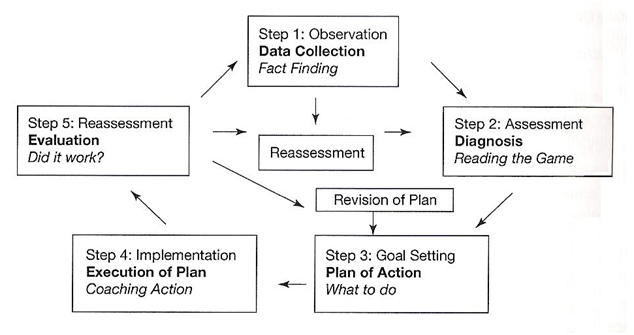Modelling Your Coaching Practice (Part 1)
Numerous academic researchers have attempted to encapsulate and explain the nature of sports coaching through the development of ‘models’ (Lyle, 2002). The desire to do so is based on the assertion that the ability to identify, analyze and control variables that affect athlete performance is central to effective coaching. In addition, much of the research literature is designed to aid future research into coaching practice as well as acting as a useful tool for coach education and training (Cushion, 2001; Mallett, 2007). However, the current level of academic discourse of representing (or modelling) the coaching process or coaching practice has not reached a consensus point at which there is sufficient weight to any particular characterization of coaching (Mallett & Côté, 2006). This loosely sequential view of coaching suggests that improved coaching practice can be attained through a planned, coordinated and progressive process. Consequently, within this body of knowledge, a number of key issues which center around the extent to which models are derived from research into practice (models ‘of’) or derived from theoretical or conceptual assumptions (models ‘for’) have been identified (Abraham et al., 2006; Cushion et al., 2003).
In the existing literature there a four commonly cited models for coaching: Franks et al. (1986); Fairs (1987); Sherman et al. (1997); and Lyle (2002). However, due to word constraints within this assignment, the author will only show appreciation towards the ‘driving force’ of recent interest in the concept of modelling coaching practice – Fairs’ (1987) ‘objectives model’.
The ‘objectives model’ (Fairs, 1987) is based on a progressive five-step idealistic framework involving a series of orderly and interrelated steps: data collection; diagnosis; action planning; implementation of plan; and evaluation (See Figure 1). Fairs (1987) claims that the model is very specific to coaching and should be referred to as a systematic ‘process’ – it is “not a haphazard, trial and error affair but involves a series of orderly, interrelated steps” (Fairs, 1987: 17). This systematic approach depicts that the coaching process as a continuous cyclical pathway, allowing procedures and outcomes to be constantly assessed and revised (Cushion et al., 2003).
Figure 1: The Objectives / Coaching Process Model (Fairs, 1987)

(Source: Lyle, 2002: 88)
However, whilst appearing logical and interrelated, the ‘objectives model’ has been relentlessly criticized by several researchers (Cross & Ellice, 1997; Mathers, 1997; Lyle, 1999; Cushion et al., 2003) because of its simplistic nature and limited use. Moreover, Lyle (2002) has suggested that the model also fails to consider long-term planning (instead adopts a coaching episode approach), illustrate the complexity of the coaching process and coaching practice, explain discrepancies in the interpersonal coach-athlete relationship, distinguish distinct differences between performance and participation coaching, adequately describe how the process might operate in practice, and take account of the model can be adopted within various coaching contexts.
It is important to acknowledge the enormity of the task to ‘model’ the complexity of coaching process without being too simplistic and failing to encompass essential elements of coaching practice (Cushion et al., 2003). Consequently, it becomes apparent that there is a range of issues and an element of ambiguity regarding the modelling of coaching practice.


